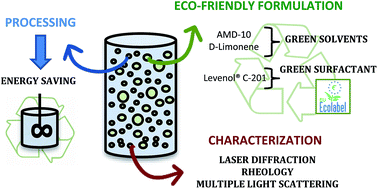Optimization of a green emulsion stability by tuning homogenization rate
Abstract
Green chemistry increases the design of new products and processes that consider the reduction or removal of the use or production of hazardous substances. This study is focused on the development of stable emulsions using ecofriendly ingredients, taking into account that energy requirements should be minimized. The physical stability of the emulsions studied was explored by means of a combination of different techniques, such as laser diffraction, multiple light scattering and rheology. The coalescence process was detected, not only by laser diffraction measurements, but also by the analysis of the plateau modulus with aging time. This rheological parameter was also useful to distinguish between grades of flocculation. In addition, the Turbiscan stability index showed that the stability was enhanced at higher homogenization rates for 30 wt% emulsions, and the opposite was true for 40 wt% emulsions. The results obtained from the combination of different techniques demonstrated that the most stable emulsion was achieved with the 40 wt% dispersed phase, using less energy input, which lies at the heart of a sustainable society.


 Please wait while we load your content...
Please wait while we load your content...